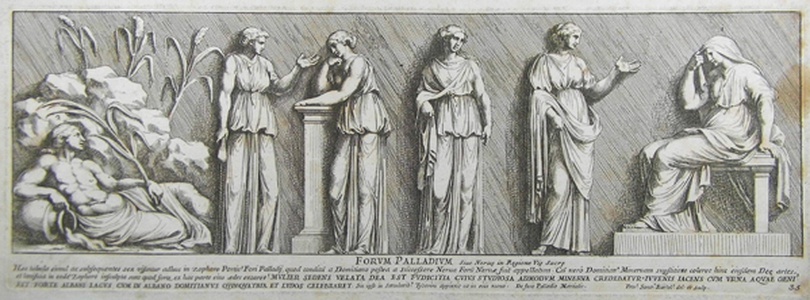| Method | Etching |
| Artist | Pietro Santi Bartoli |
| Published | Domenicus de Rubeis Chalcographus Anno MDCXCIII. Romae ad Templum Sa. Ma. de Pace, cum Privil. Summi Pont. et Licentia Superiorum [1693] |
| Dimensions | Image 123 x 136 mm, Plate 143 x 400 mm, Sheet 216 x 460 mm |
| Notes |
A depiction of a Roman relief panel from the Forum of Nerva, Plate 35 from Bartoli's Admiranda Romanarum Antiquitatum (1693). In the notes to the plate, Bartoli and Bellori, despite being well informed about the origins of the structure, continue to use the vernacular name of the Forum, the Foro Palladio, named for the temple of Minerva (Athena Pallas) that once stood at its western end. The seated, veiled figure on the right of the scene is identified by Bellori as Pudicitia, the goddess of modesty. On the left of the scene, a personification of Lake Albano is depicted leaning against a rock, holding an ear of wheat and an urn of flowing water. Every year at his villa in the Alban Hills, Domitian had celebrated the festival of the Quinquatria in honour of Minerva. The Forum of Nerva, also known as the Forum Transitorium, was the smallest of the Imperial Fora. The Forum occupied a narrow corridor of land between the earlier fora of Augustus and Vespasian. Construction began in AD 85, during the reign of the emperor Domitian, but was finished and dedicated by his successor Nerva. The Forum was transected by the Via Argiletum, a street joining the residential Subura and the Republican-era Forum, and frequented by booksellers and leather-workers. Unlike the other imperial fora, the Forum of Nerva was edged not by colonnades, but by a series of protruding columns. In this, it is similar to a number of other Domitianic structures. The frieze that decorated the inner wall of the forum featured scenes of the goddess Minerva, Domitian's patron deity, and in particular the mythic cycle of Arachne, who was turned into a spider by Minerva for arrogantly boasting that her weaving skills eclipsed those of the goddess. The Admiranda Romanarum Antiquitatum ac Veteris Sculpturae Vestigia Anaglyphico Opere Elaborata ex Marmoreis Exemplaribus was one of a number of illustrated volumes on antiquarian subjects published by the prolific de Rossi family. The work featured 83 etched plates by the antiquarian and engraver, Pietro Santi Bartoli, depicting examples of Roman relief sculpture, all of which Bartoli had viewed and studied in the various papal and aristocratic collections across Rome. Like many of Bartoli's works, the plates of the Admiranda Romanarum Antiquitatum included commentary and notes by the celebrated antiquarian, Giovanni Pietro Bellori, with whom Bartoli enjoyed a long and fruitful academic partnership. The work was dedicated by the publishers to Cardinal Flavio Chigi, nephew of Pope Alexander VII and a member of the powerful Chigi family, who had died in September 1693, the same year as its publication. Cardinal Chigi had been a close friend of Bartoli's patron, Queen Christina of Sweden. His position in such a powerful papal family had also been beneficial to engravers and publishers, particularly those with an interest in classical architecture. Alexander VII had been one of the great 'builder' popes, whose term had endowed Rome with numerous churches, public fountains, gardens, and palazzi in the rococo style, as well as encouraging the excavation, documentation, and in some cases, restoration, of the monuments of the classical era. Many of the relief sculptures depicted in the Admiranda Romanarum Antiquitatum had been rediscovered in these excavations, and were quickly added to the collections of the Chigi family and their peers. Pietro Santi Bartoli (1635 – 7th November 1700) was an Italian draughtsman, architect, antiquarian, and engraver. Born in Perugia, Bartoli apprenticed with Jean Lemaire and Nicholas Poussin. Although he would give up painting following Poussin's death to focus on engraving, the classical scenes that were the speciality of Poussin and Lemaire were probably responsible for the young Bartoli's interest in classical subjects. In collaboration with the antiquarian Bellori and the publishers Giovanni and Domenico de Rossi, Bartoli produced a number of works documenting the art, architecture, history, and culture of ancient Rome. Of particular note are his series of 128 etchings depicting details of the frieze on the Column of Trajan, and a number of plates of Roman monuments after Giacomo Lauro that were published by Domenico de Rossi in his Romanae Magnitudinis Monumenta in 1699. Condition: Foxing to sheet, mostly to bottom and right margins. Stain to right edge of image. |
| Framing | unmounted |
| Price | £50.00 |
| Stock ID | 25358 |

